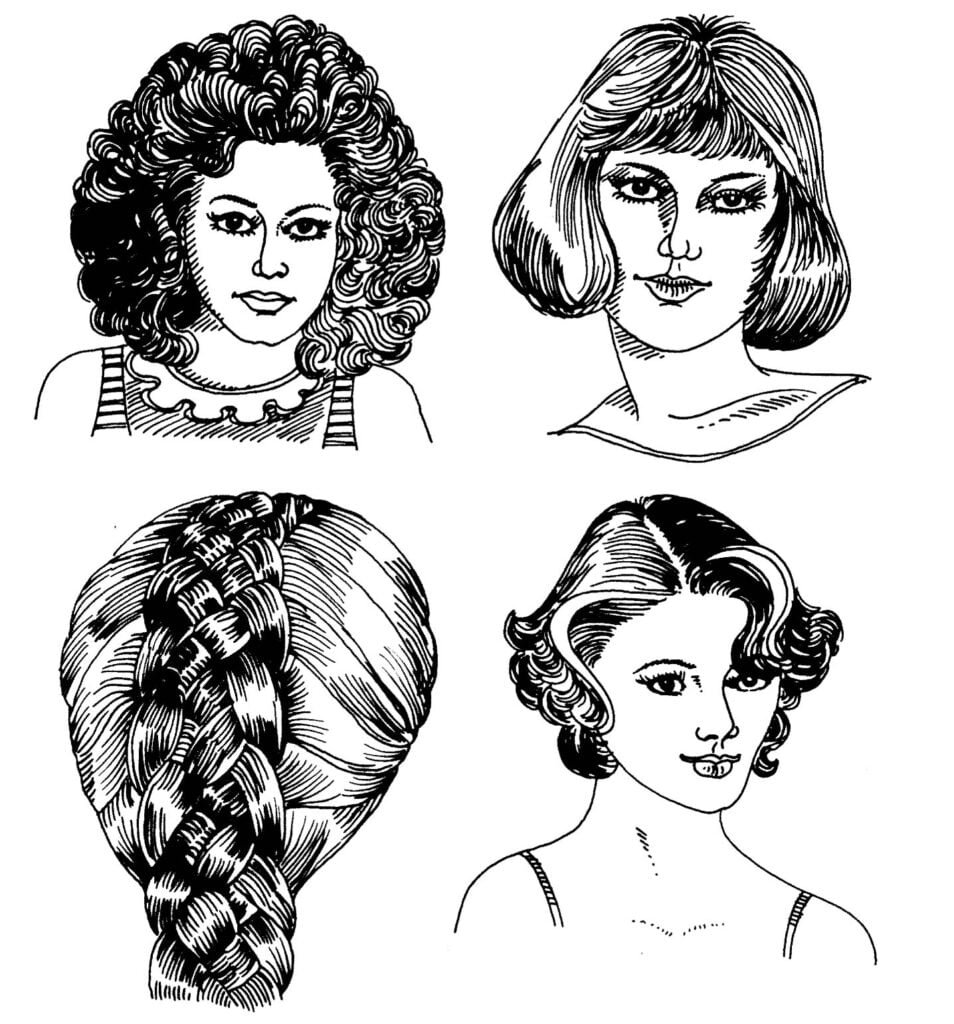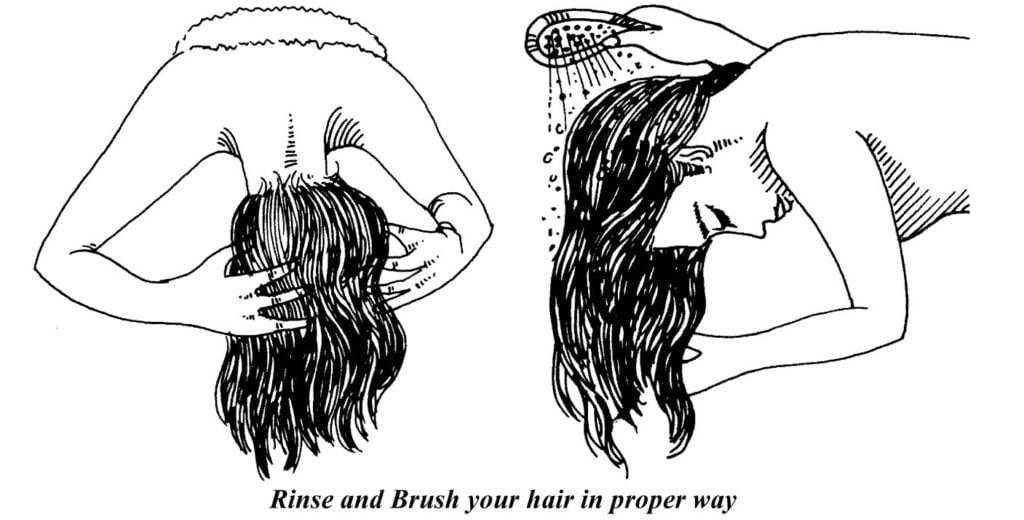Here are some questions and answers for normal care of your hair.
Which is better—combing or brushing?
If you use a soft brush, brushing is less damaging then combing, but a stiff brush does cause more damage to the hair than a comb. Prolonged brushing also harms the hair considerably. So the proverbial 100 strokes a night may actually harm the hair. Back-combing also damages the hair. It ruffles the scales of the cuticle as well as it causes knotting which is difficult to untangle.
Wet hair should never be combed or brushed because hair sticks together when wet and a greater force is required to comb or brush it and this causes greater damage to the hair. Moreover, the bonds (hydrogen bonds) which are responsible for the strength of the hair are broken temporarily when the hair is wet. This makes wet hair weak and more likely to be broken by combing or brushing.
A good comb should have rounded and not sharp teeth. Brush ends should also always be rounded to minimise mechanical damage to the hair. Nylon brushes with spiky ends also damage the hair. The best hair brushes are made of bristles from the hair of wild boar—the tiny scales on the bristles clean the hair and give it a sheen.
How to choose your shampoo?
The aim of shampoos is not only to clean the hair, but to beautify it as well. Most shampoos are detergent based. To this are added several chemicals—stabilisers, preservatives, conditioning agents, perfumes and colours.
A shampoo should be judged by its performance, not by its appearance, colour, perfume and definitely not by its price. It should clean the hair and rinse out easily, leaving the hair smooth and manageable. Lots of lather is not a measure of its efficiency, though it may indicate a high detergent content. Neither does a thick consistency mean that the shampoo is more concentrated.
There is a good range of products—labelled as ‘for oily hair’, ‘for dry hair’, and ‘for normal hair’. The differences between these shampoos is in the type of the detergent used and also in the concentration of the detergent used. Shampoos with high detergent activity are based on anionic surfactants and those claiming mildness generally contain non-ionic surfactants. Scientific studies have shown almost identical efficiencies for various shampoos, whether designated for oily or dry hair. All shampoos do leave behind a constant residue of oil because this is beyond the reach of surfactant—this is nature’s way of protecting the hair fibres from injuries.

Regarding the pH of shampoos, it is generally agreed that neutral or slightly acidic shampoos are better for the hair, especially the hair that has been physically or chemically damaged. This is because the acids precipitate proteins on the hair surface which acts as a protective coat for the damaged hair.
How safe are shampoos?
Shampoos are very safe for the hair because they do not contain any harsh detergents, therefore the natural coating, the hydrolipidic film, is retained on the hair. Excessive cleansing, may sometimes give rise to a ‘flyway condition’ of the hair. The hair then becomes unmanageable due to ‘static’ build up. The main problem, with shampooing, however, is the mechanical abrasion of wet hair caused by rubbing movements while shampooing and by towel drying. Reactions to shampoos are infrequent; the main problem is the irritation of eyes but the newer detergents and chemicals in baby shampoos are free even from this problem.
How often should you wash your hair?
This depends on the type of hair and scalp, and also on the environment. If your hair is greasy then you would need to wash it frequently, say even 3-4 times every week. This is especially necessary, if the environment you work in is dirty. Frequent shampooing is not harmful for the hair.
Do exotic shampoo ingredients have any real effect on the hair?
Despite their popularity and appeal, many of the shampoo additives do not really benefit the hair, simply because they are quickly rinsed off the hair in the shampooing process. However some products, egg and beer for instance, may cling to the hair and impart apparent body to the hair and act as conditioning agents.
Some shampoos contain exotic, natural additives like—collagen, gelatin, allantoin, and henna. Gelatin, which is nothing but the simplest of collagens, is almost ineffective. Broken down gelatin gives additional body and softness to the hair. Experiments have shown that it may be possible to even repair split ends, under optimal pH conditions, with hydrolysed gelatin. Amino acids and panthenol are added to some shampoos because they give body to the hair. Henna is another ingredient being used in more and more shampoos. The extract which is added is colourless and gives body and gloss to the hair without any colouration.
How do conditioners work?
There is nothing long lasting about the effect of conditioners but they definitely do have a temporary magical effect on the hair.
Degradative changes of the hair are caused by combing, brushing, washing and drying. The scales of the hair cuticle are damaged—these then curl up and break. Since smooth overlapping scales are essential for shiny hair, the damaged hair appears dull and lifeless.
Conditioners do not penetrate the outer layer of the hair shaft— they merely coat the hair, helping to flatten and smoothen scales. A fine fatty film is deposited on the hair shaft; this temporarily fills in broken patches in the cuticle, just like plaster does over cracks in the wall. This softens the hair and gives it shine and body. Conditioners also restore the protective acidic film which is reduced during shampooing.
Hair is ‘electrically changed’ immediately after shampooing. So it easily tangles and becomes difficult to manage. The active ingredient of most creme-rinse conditioners is a cationic surfactant. This reduces the friction between hair bibres and increases surface conductivity, so the electric change is lost and hair becomes manageable.
Which conditioner to choose?
Conditioners are generally used after shampooing. Creme-rinses are kneaded into the wet hair immediately after rinsing off the shampoo. The hair is then rinsed thoroughly after 1 to 2 minutes. If the conditioner is not rinsed off well, the hair may appear greasy.
Sometimes the conditioning agents are incorporated into shampoos; the conditioning performance of such combination shampoos is inferior to the performance of the 2-stage shampooing and conditioning. Newer conditioning agents have, however, been added to shampoos without loss of the conditioning effects.
The term ‘balsam’ is frequently mentioned in connection with creme-rinses. The term is applied to conditioners which contain plenty of oils and protein. Exotic natural additives such as collagen, gelatin, allantoin and henna are also being used in the conditioners. Some of these have questionable effect while others add to the body and shine of the hair.
Are conditioners safe?
The conditioning compounds are not without adverse effects. The hair may be softened too much–this happens frequently with thin hair. A major problem with cationic agents is that they are highly irritating to the eyes and many cause defective vision due to the development of cataracts. As this happens with higher concentrations of the conditioning chemicals, their levels should be strictly controlled.
How made rinses for your hair?
Lime juice, vinegar and tea water are often quoted as good hair rinses. They, in fact, do not offer the benefits of the easily available commercial conditioners. In the days when people used soap to wash their hair, a dull covering formed over the hair in the presence of hard water. All the above being acids, helped remove the soap scum. Now-a-days this quality is of no value as the detergents used in modern shampoos do not precipitate with hard water. However, since most shampoos are alkaline, these acids do neutralise the residual effects of the shampoos and may form an acidic coating on the hair.
Injured Hair
What is the cause of split ends?
If it is not cut, the hair can grow to a length of 40 to 80 cms. During its long stay on the scalp, the hair is exposed to innumerable physical and chemical traumas—combing and brushing, shampooing, weathering and chemical treatments. These factors are all the more damaging to hair because hair is a dead structure that lack the power of self-repair. The cumulative effect of all these injuries is the gradual wearing down of the cuticle scales—these are totally lost at the tips of the hair and this results in split ends.

What can we do about split ends?
Though we cannot refrain from injuring our hair, careful grooming of the hair is likely to delay the appearance of ‘splits’: avoid rubber bands, spiky brushes and combs; avoid combing wet hair. Conditioners protect the hair against physical injury to some extent, so use them regularly. Once splits have appeared, it is a good idea to trim off the straggly ends to give a healthy appearance to the hair. There is no definite way to mend split ends. Conditioners coat the hair and may temporarily bind splits, making them less obvious. Conditioning the hair with digested gelatin has been found useful.
Chemical treatment of hair
Chemical hair treatments include bleaching, oxidative dyeing, waving and straightening of the hair. The integrity of the hair fibre depends on the presence of bonds between various hair proteins. Chemical treatment of hair results in the breaking of the disulphide bonds, most of which are later reformed. However, even under the best of conditions, ten percent of the broken disulphide bonds are not reformed, resulting in some residual weakness of the hair. So repeated procedures could eventually break the hair.

